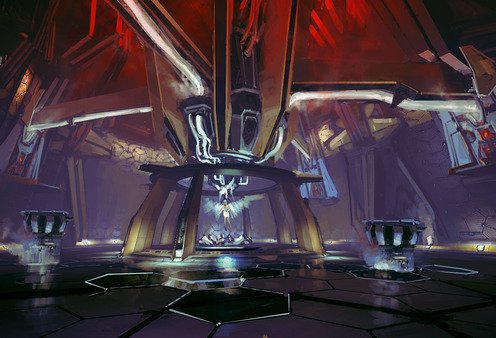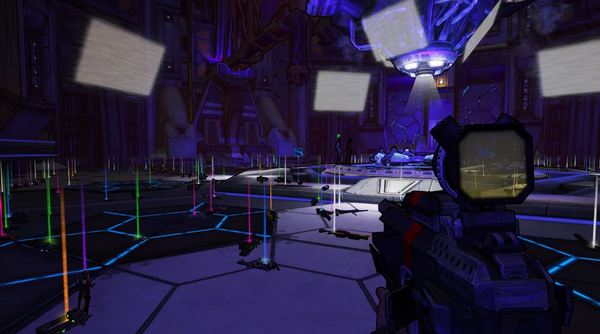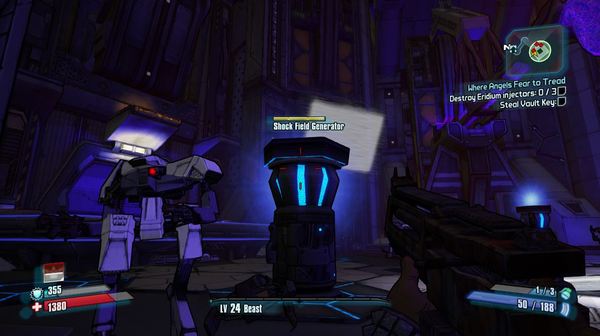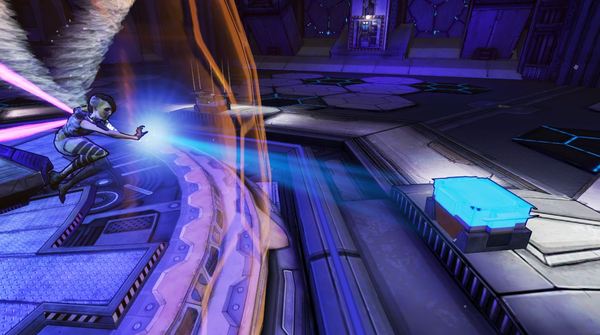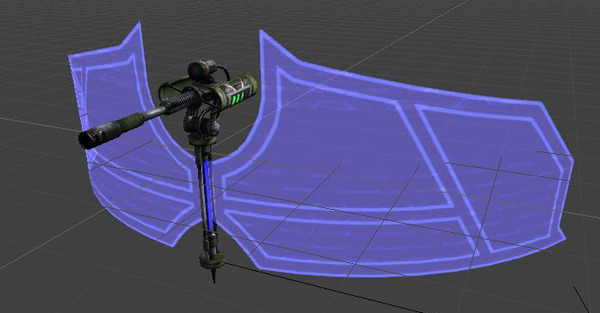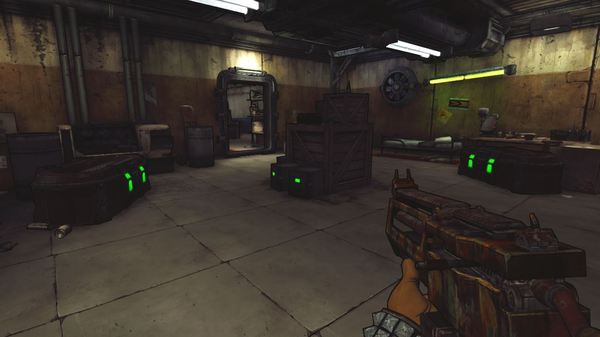
Inside the Box serves as a forum for individuals involved in the production of Gearbox Software content to share personal motives, methods, process and results. Gearbox Software projects are created by a diverse range of individuals spanning a spectrum of different backgrounds, interests, objectives and world views. The views and opinions expressed in this article are those of the author and do not necessarily reflect the official policy or position of Gearbox Software or any of its individual members outside of the author.
Control Core Angel: Alive and Supplied
In my previous Inside the Box article, I talked a little bit about Angel’s intro, leading into Control Core Angel. In this article, I will touch on some of challenges we faced when implementing the battle itself. A word of warning: I’m going to be discussing some of the most spoilerific moments in Borderlands 2. So, more than just a Spoiler Alert, this is Spoiler DEFCON 1!
Ah, who am I kidding? If there was anything left to spoil by this point, Anthony Burch has already done it in his excellent Inside the Box articles. By the way, if you’ve missed any of those, you should be sure to go and check ’em out.
An early concept sketch of Control Core Angel.
Designer as Parent
Like many of us at that age, my eight-year-old son is a game designer. He’ll draw out a Mario level on a piece of graph paper, or use his Magna-Tiles to build the interior of a castle, brimming with nefarious traps and a complete set of rules regarding the fate that awaits the poor hero who happens to step on that colored piece of the floor. Whenever he shows me one of these creations, I’ll have him talk me through the entire adventure.
And a harrowing adventure it is! After he describes the third or fourth grisly end for the putative player of his game, I’ll ask him how the hero is meant to overcome all of these traps. By now, he’s familiar enough with the question that it’ll earn me a long-suffering roll of the eyes; a succinct expression of the unbearable burden that is having a father who does this sort of thing for a living. Clearly, I’m challenging him with an entirely new line of thinking, one that fights with the elegance of his original design for a player slaughterhouse.
My son, the game designer. He just thought up five new ways to kill the player.
It’s an understandable mistake, and even professional designers can easily fall into the trap. In some ways, the act of designing a game itself feels like a game that the designer is playing, and one mistake we make is thinking that the goal of the game is to beat the player. More than once, I’ve challenged a fellow designer to put themselves into the shoes of the player and to imagine what a particular experience would feel like from the other side. “Don’t hate the player,” I’ll say, usually earning another roll of the eyes. Yes, the designer may have built a slaughterhouse, but he must also serve as the player’s guide through that dark place.
One of the best ways to offer such guidance is to only hint at the solution, or to obscure it just enough that the player is discovering the path to success through their own reasoning and skill. That’s fun, and in that regard, being a game designer is not unlike being a parent.
Fighting In the Waiting Room
From the start, Paul Hellquist and Anthony Burch intended the battle in Control Core Angel to be a narrative vehicle. Jack, Angel, Roland, and Lilith all delivered their lines while the combat served as a backdrop and offered the player something to do while they waited for the exposition to finish. It was never supposed to be especially challenging, because too much challenge would distract the players from all those plot points the narrative was trying to get across.
The problem with combat is that it’s dangerous to players and it consumes resources like ammo and health. Once again, the game designers were dropping the players into a slaughterhouse, so we needed to provide them with the means to survive the experience, and hopefully to have fun while doing so.
Since we wanted Angel to be visible and present during all that exposition, Control Core Angel had to be a wide open arena, and that created its own set of challenges for the designers. An arena goes against the standard Borderlands loop a little, because there are no places of safety to hide and recover in, and there are no hidden nooks to explore and find lootable boxes filled with ammo or health.
Control Core Angel also went against the Borderlands core loop in another key aspect: we planned to teleport the player out of the room at the end. There were good reasons to do this, like demonstrating how Lilith was badass enough to resist Jack’s command collar, and keeping Jack safe from player retaliation for the moment. Just as it did back at the end of Hunting the Firehawk, though, teleporting the player away from a recent battlefield meant potentially depriving them of loot. Unfortunately, unlike the Firehawk Lair, there would be no way for me to add a little bridge that let players hop back down and peruse the spoils of war.
These were the sorts of challenges I needed to solve as a designer, so that we were helping the player enjoy an experience, and not just throwing them to the wolves.
Sorry, you can’t take it with you.
Finding Cover in an Arena
In an early version of Control Core Angel, the floor of the antechamber entrance was coplanar with the floor of the main arena. The ledge that’s there now wasn’t present back then, and the doors didn’t close. When I started implementing the combat encounter, that antechamber turned out to be the only safe place to rest and recover. That wasn’t going to work. If AI navigation was available inside the antechamber, then enemies would eventually find their way in, and there’d no longer be a safe spawn point for late-joining or dead players. If I removed AI navigation, then players could stand in the room forever and snipe enemies from a position of safety.
So, we raised that ledge near the door, we made the door itself auto-close, and I removed AI navigation from the antechamber, to ensure that robots could never get in there. Then, I added a subtle force field to the door to prevent the strategy of lingering in the doorway and taking pot-shots at enemies who couldn’t reach you.
With that change, there was now almost no place for players to take cover from enemy fire. The only thing a player could do was put Angel’s bubble shield between themselves and the enemy, but what could they do when they were surrounded? More cover options needed to be added to the room.
Around this time, there was a push to add some of the cooler tech bits to the room. After all, Control Core Angel was supposed to be the most advanced facility on Pandora; it needed more lasers and more technology! Some of the concept art, like the piece shown above, featured hexagonal pillars rising from the floor. I didn’t know exactly what the artist intended them to be, but they looked like they could serve as some sort of high tech defense mechanism for the room.
So, the Shock Field Generator was born. They rise up from the floor, and they shoot an electric beam at any player that comes into their proximity. More importantly, if the player destroys it, then it remains in place as a harmless pillar, thereby providing a small amount of cover to hide behind.
A Shock Field Generator in its natural habitat.
A Steady Ammo Supply
With cover provided, the players could now survive long enough to run out of ammo, which was the next problem I needed to address. From the earliest iterations of this room, I’d always placed normal ammo chests around Angel’s shield bubble. Unfortunately, I was trapping players inside the room, which meant that however much ammo I placed, a player could still eventually run out.
I probably could’ve made a judgment call and simply placed however much ammo I felt was necessary to finish the battle. That option didn’t sit well with me, though. In Borderlands, there are a lot of variables with regards to ammo consumption. How many players are there? What kinds of weapons are they using? What playthrough is this? Are they very skilled players, or not so much? Remember that this particular battle was never intended to be especially challenging.
The enemies can drop ammo, too, but that potentially creates a situation where the player would need to use ammo to get ammo, and I didn’t like that either. When I imagined the experience of a wide variety of players, I kept thinking that there would be some small subset who would find themselves running around in a room full of enemies, completely out of ammo, and cursing my name because their only option was to die and start over. I needed to make sure I took care of that person.
Fortunately, Josh Jeffcoat and the other designers working on the The Warrior boss battle had already encountered a similar problem and solved it. They were using “Digistruct” technology to spawn fresh lootable chests. Since Angel was a super high-tech Siren, it made sense that she would use this same method to help the players out. Best of all, she could respawn ammo chests over and over, infinitely, until the end of the battle. Players would now never run out of ammo.
Angel digistructs a fresh ammo chest. If you watch her fingers closely, Dia Hadley (Animator) made her look like she’s typing on a keyboard. It’s supposed to be technology at work here, not magic!
Universal Health Care
Trapping players in a room with a bunch of robots that wanted them dead presented yet another problem: the players could run out of health! For the same reason as the ammo, I figured I would need to offer up an unlimited supply. The ammo chests spawned some, and the robots could drop some, but I wanted something cooler.
A rather convenient solution soon presented itself. By this time, I had an AI-controlled Roland fighting alongside the player, and his Action Skill in Borderlands 1 was the Scorpio Turret.
The Scorpio Turret was actually a bit of dumb design luck for me, because in Borderlands 1, Roland had several supplemental skills that seemed perfectly made to alleviate the problems I encountered with the Control Core Angel battle. The turret came equipped with a sort of barricade that the player could take cover behind. The Stockpile and Supply Drop skills could provide players with ammo. Best of all, the Aid Station skill increased the health regeneration rate of any players in proximity. So, here was a health supply that was also pretty cool, and had the additional gameplay of requiring players to hover around Roland’s turret to take advantage of it.
It was easy enough to pull over the art assets for the Scorpio Turret from Borderlands 1, but the coders had extensively revamped the player skill system for Borderlands 2, such that I couldn’t just copy the functionality over. Just as I had with Lilith and Brick’s Action Skills, I was going to need to recreate Roland’s Scorpio Turret from scratch using the new systems. Fortunately, my desk was right next to Jonathan Hemingway’s, and he was the designer of all the player characters from both Borderlands 1 and 2.
Jonathan explained to me how Roland’s skills worked, so recreating them in the Borderlands 2 system was a snap. I even added some of my own flourishes, like changing the Aid Station effect to work more like a transfusion grenade, and adding a particle trail effect to the tiny little floating crates spawned by the Supply Drop skill. I also added one more skill to the turret that didn’t exist in Borderlands 1: the turret explodes when its duration expires, damaging nearby enemies.
That was it! Roland’s Scorpio Turret turned out to be a pretty great way to help keep the players “alive and supplied” while trapped in Control Core Angel.
Roland’s Scorpio Turret, as it appears in the development tools.
What About Loot?
I mentioned earlier that we knew teleporting the player out of Control Core Angel at the end was going to break one of the core loops of Borderlands: players wouldn’t be able to pick up any loot that had dropped. Also, I wasn’t going to be able to provide players with a path back into the room to pick up anything they’d left behind.
So, I set up the item pools to drop nothing but consumables like health and ammo items. There is no loot at all to be had from that battle. Enemies won’t drop it, and the loot chests won’t spawn it. It sucks, but leaving a rare gun on the ground while you innocently turned in the mission, only to be spirited away without warning, would suck more. Not dropping any loot is simply making the best of a bad situation.
It’s no accident that Lilith happens to teleport the player into the Marcus Munitions Storeroom. You may have noticed that no map load is incurred at the end of the cutscene. That’s because the storeroom is actually still in the same level as Control Core Angel; I’m just teleporting the player into a separate room that uses the Sanctuary art set. If you open up the tactical map, you can still see Angel’s room off to the side.
By teleporting the player into the storeroom, we tried to ameliorate the loot problem. There, the player is treated to four big loot chests, three of which are the “epic red” variety. It’s practically the highest loot density in the game, which is why I never allow players to return, and made it one of the only missions that actually tracks and remembers which chests the player has opened. (So that a player couldn’t loot the chests, then save and quit, then loot the chests again, ad infinitum.) In this way, we tried to give the players the loot that they would otherwise have gotten during the battle.
The Marcus Munitions Storeroom
And so, we come to the end of another Inside The Box article. I hope you’re finding these little insights into game design to be interesting and entertaining. I also hope my son, the game designer, will read this someday, and maybe then he’ll add some health potions to those Magna-Tile dungeons of his. Right after he’s done yelling at me for using that photo. Anyway, thanks again for reading, and I hope to see you next time!


